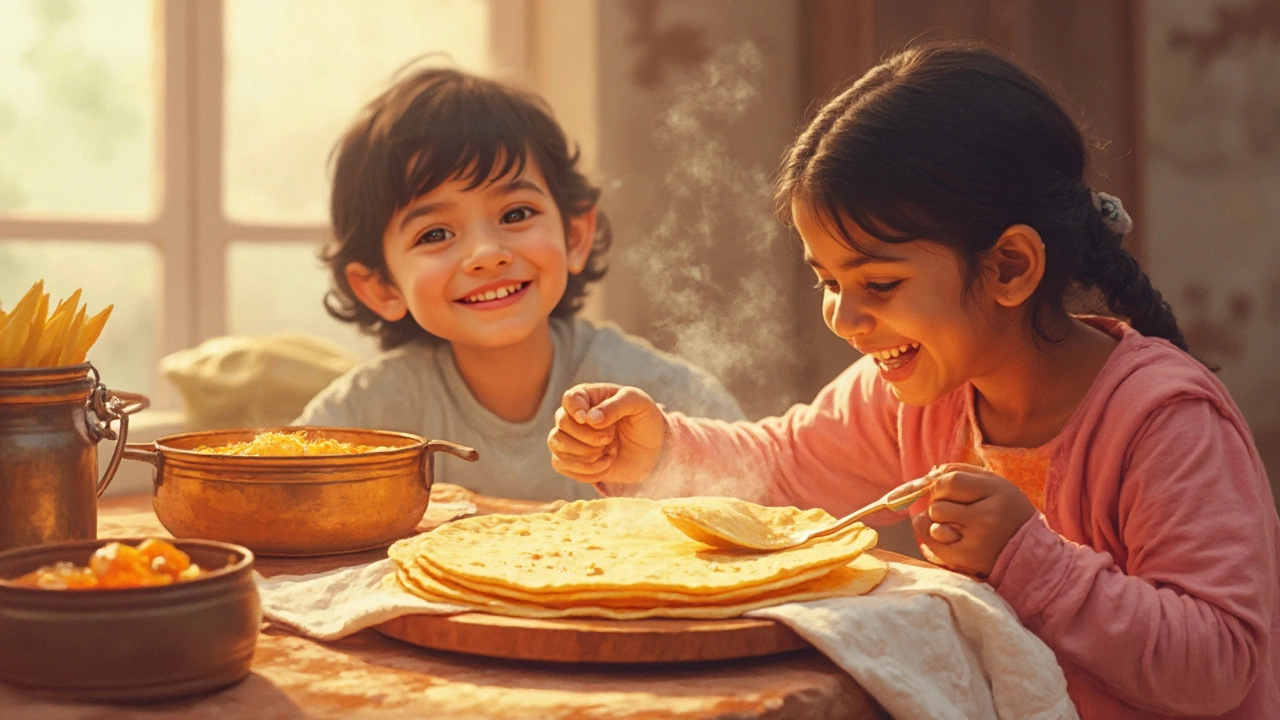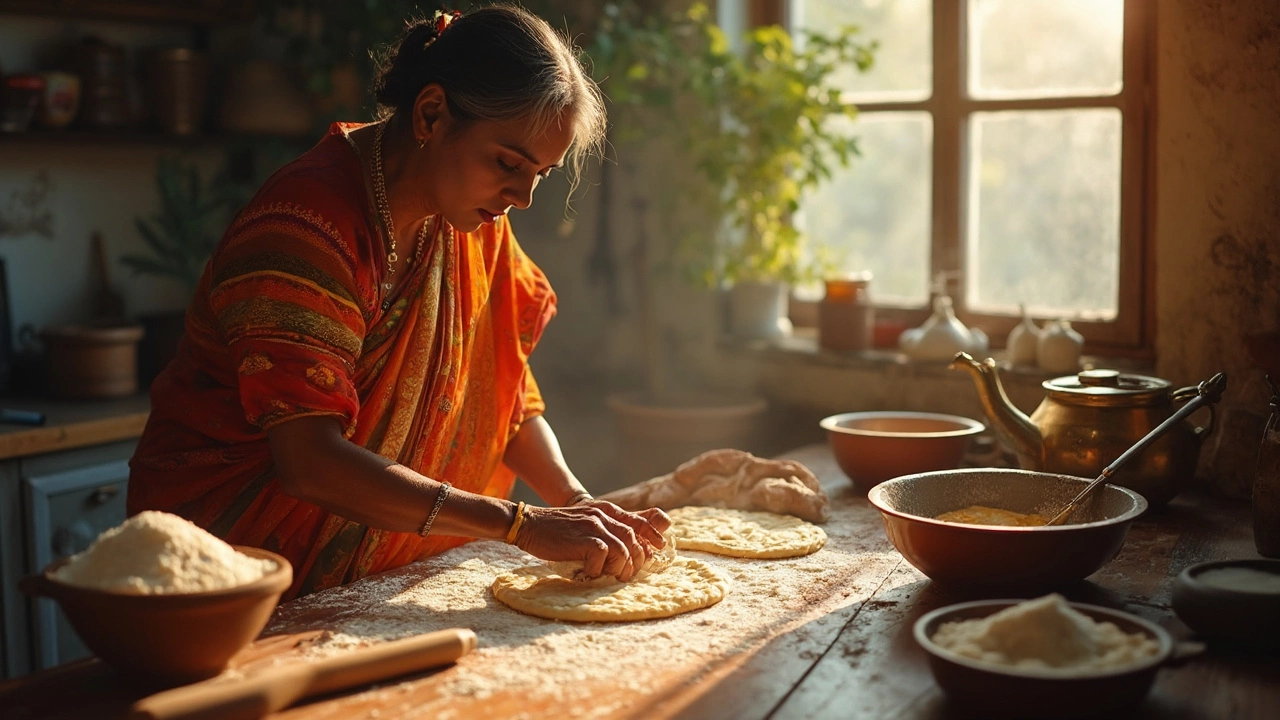Ever wonder why your chapatis come out stiff when your friend's are unbelievably soft? You might be missing a couple of small steps that make a big difference. It's honestly not about buying special flour or fancy gadgets. The secret hides in the dough and what you do with it.
First up, the water. Too little water and your dough stays tough, too much and it gets sticky and impossible to roll. Get it just right, and your chapatis will feel silky and soft even before they hit the pan. And here’s a tip most people ignore: always let your dough rest at least 15 minutes. This little pause does magic, making the gluten relax so your chapatis puff up and don’t get chewy.
The softest chapatis aren’t all about hand strength, either. Don’t overwork the dough—stop kneading once it’s smooth. If you’re worried about the dough drying out, cover it with a damp cloth. That simple move can mean the difference between roti that tears and chapati that folds like a napkin.
- The Real Reason Chapatis Turn Out Hard
- How to Knead Dough for Softness
- Rolling and Cooking: The Crucial Steps
- Troubleshooting Common Chapati Flops
The Real Reason Chapatis Turn Out Hard
If your soft chapatis keep coming out more like frisbees than flatbreads, you’re definitely not the only one. It’s almost always about the basics, not the fanciness. The culprit is usually wrong dough consistency, skipping resting, or messing up the cooking time.
The biggest mistake? Not enough water in the dough. You need a dough that’s soft, almost a little sticky—think Play-Doh, not putty. If you use too little water, you’ll end up with dry, tight Indian bread. Add water gradually and don’t rush it. When in doubt, touch: if the dough springs back but doesn’t stick to your fingers, you’re in the safety zone.
Another sneaky reason for stiff chapati is skipping the resting part. Letting the dough chill for at least 15-30 minutes helps gluten do its thing, making your roti easier to roll and softer after cooking. If you try to roll and cook straight away, you’ll notice the chapati dries out way faster.
Even the best dough can fail if your pan is the problem. Always make sure your tawa is hot—medium-high to high heat. If you start with a cold or lukewarm pan, chapatis turn hard and lose their magic puff. Hot tawa gives rapid bubbles which keep the chapati light instead of dense.
- Too little water = tight, hard chapatis
- Forgot to rest the dough = chewy, stiff texture
- Cold pan = no puff, dry roti
To make things easy, here’s a quick snapshot of common problems and fixes:
| Problem | Why It Happens | What To Do |
|---|---|---|
| Hard chapati | Too little water or not rested | Use more water, rest dough longer |
| Dry edges | Dough not kneaded well | Knead until smooth, cover dough |
| Doesn’t puff | Heat too low | Cook on a hotter tawa |
If you keep these fixes in mind, your roti making game will level up super fast.
How to Knead Dough for Softness
If you want soft chapatis, kneading the dough the right way is half the battle. Most people either rush the process or don’t mix enough water, and both can lead to rubbery results. The goal is a smooth, barely sticky dough that bounces back when you press it with your finger.
Always start with fresh, whole wheat roti making flour (atta). It’s not just a tradition—fresh flour has more moisture, which helps with softness. Here’s a super practical step-by-step:
- Pour flour into a wide bowl and slowly add lukewarm water. Using warm water actually helps gluten form faster, making the dough softer and easier to handle.
- Mix the flour and water by hand, adding water in small splashes. Don’t dump it all in at once—too much, and you’ll end up with a sticky mess.
- When the mix starts coming together, knead it with your knuckles. Push, fold, and turn. You want to do this for about 6 to 8 minutes. If the dough feels hard, wet your hand and knead a little more.
- Drizzle in just a few drops of oil once it's smooth. This simple trick can trap moisture in and stops the top from drying out.
- Shape the dough into a ball, and don’t forget—rest it for at least 15-20 minutes, covered by a damp cloth.
People often ask: how much water to use? On average, for 2 cups (about 250 grams) of atta, you’ll need around 3/4 cup (180 ml) water, but it can change depending on humidity and flour quality. Err on the side of adding less at first—you can always add more if needed.
Here's a quick cheat sheet for dough ratio:
| Atta (Flour) | Water (approx.) |
|---|---|
| 1 cup (125g) | 90 ml |
| 2 cups (250g) | 180 ml |
| 4 cups (500g) | 350 ml |
The next time you work your dough, aim for smooth and a little springy—not sticky, not dry. This simple step lays the foundation for soft chapatis that stay pillowy even after hours in your lunchbox.

Rolling and Cooking: The Crucial Steps
This is where most people trip up when it comes to soft chapatis. Rolling and cooking seem simple, but tiny mistakes can make your roti turn tough before you even notice.
Let’s start with rolling. Always divide your dough into even-sized balls—about the size of a small lemon. Dust each with dry flour before rolling. Don’t press down too hard. Gentle, light rolls give you even, thin chapatis that puff up easily. If you see jagged edges, knead the ball again for a second and try rolling it out. For absolute beginners, your chapati should be about 6-7 inches in diameter—not paper thin, but definitely not thick like paratha. Uniform thickness helps them cook evenly.
Now, onto the cooking. Your tawa or pan should be hot—if you sprinkle a few drops of water and they sizzle away, that’s perfect. Avoid using oil at this stage; dry-roasting helps them puff and stay soft. Follow these steps for the best results:
- Place the rolled dough on the hot tawa. Wait for spots to appear (10-15 seconds), then flip it.
- Let it cook on the other side until small brown spots show up. Don’t let it become dark brown.
- Flip again and press it gently with a cloth or spatula. If it puffs, you nailed it!
If they aren't puffing, don’t worry—it takes practice. But here’s a fact: chapatis that puff are almost always softer inside. Some people use a direct flame after the tawa to get that perfect balloon effect.
| Common Mistake | Result | Fix |
|---|---|---|
| Rolling uneven chapatis | Portions cook at different speeds, hard spots | Roll evenly, practice pressure |
| Cold tawa or pan | Chapati dries out, gets hard | Heat pan fully before starting |
| Cooking for too long | Stiff, chewy chapati | Quick cooking at high heat |
Remember, the goal is fast cooking on high heat. Quick flips and gentle pressing help keep your chapati fluffy. If you’ve nailed the earlier dough steps, this part will naturally get easier each time.
Troubleshooting Common Chapati Flops
Sometimes, even when you follow all the classic roti making tips, things go sideways. Maybe your soft chapatis turn out like crackers, or they puff up unevenly, or worse—don’t puff at all. Let’s dig into the most common mess-ups and how to fix them.
- Chapatis Are Hard or Dry: If your chapatis are hard, your dough probably needs more moisture. A dry dough just can’t yield soft chapatis. Try adding an extra tablespoon or two of warm water next time you knead. Also, don’t skimp on dough resting time; it’s essential for softness.
- Chapatis Don’t Puff Up: Puffing means steam is trapped inside. If yours stay flat, roll them evenly, not too thin or thick, and make sure your tawa is preheated. If the first chapati doesn’t sizzle the second it touches the pan, the tawa isn’t hot enough.
- Roasted Spots or Burn Marks: Black spots usually mean uneven heat or heavy-handed rolling. Aim for even thickness and medium-high heat. If you see dry spots, the dough probably needs more kneading or better coverage during resting.
- Edges Crack or Tear: Cracking means your dough dried out. Keep your dough covered with a damp cloth until you’ve rolled every chapati. If needed, knead in half a teaspoon of oil for extra flexibility.
- Chapatis Sticking to Surface or Rolling Pin: Too much moisture or not enough dry flour for dusting is usually the culprit. Lightly dust your board and pin, but don’t overdo it or chapatis get tough.
Still stumped? Here’s a breakdown of errors and quick fixes you can refer to in one glance:
| Problem | What Went Wrong | Quick Fix |
|---|---|---|
| Hard chapatis | Dough too dry or not rested | Add a bit more water and let dough sit 15-20 min |
| Chapatis not puffing | Pan not hot, uneven rolling | Preheat pan, roll evenly |
| Black/burn spots | High heat, uneven thickness | Lower heat, check rolling |
| Cracking edges | Dough dried out | Cover dough, add oil |
Don’t get discouraged. Even pro cooks have off days with roti. Tweak one thing at a time, and pretty soon, Indian bread that’s soft and puffy every time is totally in reach.
